Off-roading is not restricted to a single type; the required ground clearance varies from terrain to terrain. The type of off-roading can also be an important factor in determining the good ground clearance of your off-road vehicle. The minimum surface clearance will differ significantly between sand deeds and mountain tracks, and gravel tracks. What is a good ground clearance for off-roading?
Ground clearance of 8 inches to 10 inches can be the best to start off-roading. To drive through rocky terrain, ground clearance of 10 inches or more can prove to be the best for the off-road vehicle. However, to drive through well-maintained tracks, ground clearance of 6 inches should be good.
What is a Good Ground Clearance for Off-Roading?
The ground clearance can be defined in such a way that it refers to the distance between the lower end of the vehicle body and the base of tires, or we can define this term in such a way that it simply refers to the minimum ride height your off-road vehicle.
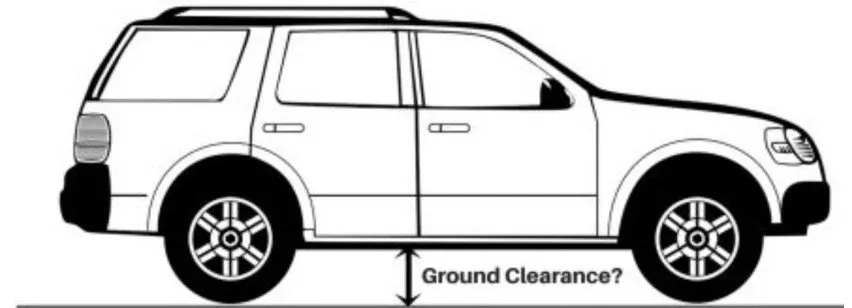
Impacts of Ground Clearance on Off-Roading:
Ground clearance is one of the most crucial vehicle dimensions that cannot be ignored during an off-road trip. It is best to know the ride height that refers to the distance measuring from the lowest part of the vehicle to the ground.
Off-road enthusiasts should possess a basic knowledge about these terms to tackle critical situations wisely.
Type-Wise Average Ground Clearance for Off-Road Vehicles:
| Type | Average Ground Clearance |
|---|---|
| Sports Coupe | 135 mm-140 mm |
| Hatchback | 168 mm |
| Compact Sedan | 170 mm |
| Sedan | 165 mm |
| Compact SUV | 190 mm – 200 mm |
| SUV | 225 mm |
Ground Clearance Set for Different Off-Road Vehicles:
| Off-Road Vehicle | Ground Clearance of The vehicle |
|---|---|
| Jeep Grand Cherokee 2019 | 6.6 inches |
| Toyota Tacoma 2019 | 9.4 inches |
| Land Cruiser 200 2019 | 9 inches |
| Ford Ranger 2019 | 8.9 inches |
| Toyota Hilux 2019 | 10.9 inches |
| Jeep Wrangler Rubicon 2019 | 10.8 inches |
| 2021 Infiniti QX80 | 9.2 inches |
| 2021 Nissan Armada | 9.2 inches |
| 2021 Mercedes-Benz G-Class | 9.5 inches |
| 2021 Toyota 4Runner | 9.6 inches |
| 2021 Lincoln Navigator | 9.6 inches |
| 2021 Ford Expedition | 9.8 inches |
| 2021 Toyota Sequoia | 9.9 inches |
| 2021 Volvo XC90 | 10.5 inches |
| 2021 Jeep Grand Cherokee | 10.6 inches |
| 2021 Land Rover Discovery | 11.1 inches |
| 2021 Land Rover Range Rover | 11.7 inches |
Ways to Measure Ground Clearance:
There are two ways to measure or determine the ground clearance of your off-road vehicle.
- One way to determine the ground clearance of your off-road vehicle is by measuring through the chassis.
- The other way to determine ground clearance is done by measuring from the diff housing.
There is also a way to reduce the distance between the chassis and the wheels by loading additional equipment, passenger, fuel, and gear.
You should know which factors can reduce the ground clearance of your vehicle. The ground clearance can be reduced from the diff or axle housing when you start deflating your tires.
Those vehicles which possess improved ground clearance can surpass obstacles easily as compared to others.
Damages Due to Incorrect Ground Clearance:
You can damage the most important components of your vehicle during an off-road journey if you don’t take care of ground clearance issues.
Those components of off-road vehicles that are on the verge of destruction mainly comprise undercarriage components, the body of the vehicle, and bumpers.
Off-roading offers the challenges of driving your vehicle through different terrains. You need to adjust the ground clearance of your vehicle according to the selected terrain.
The excellent ground clearance can protect your off-road vehicle from falling prey to destruction.
Find details on Is It Dangerous to Hit the Rev Limiter When Off-Roading?
Minimum Ground Clearance:
Suppose you plan to proceed with your journey through forest service roads or mild jeep tracks and are not interested in taking the challenges imposed by dangerous types of off-roading such as rock crawling. In that case, you can have a safe journey even with minimum ground clearance.
You are advised to proceed with your journey through dirt roads or other well-established trails if you are willing to proceed with minimum ground clearance.
But, if your vehicle holds high ground clearance, you can take your off-road vehicle to many different off-road terrains with minimum risk.
How Much Ground Clearance do You Need for Speed Bumps?
It is absurd to ignore the importance of ground clearance for your vehicle. If you want your vehicle to tackle speed bumps, you have to adjust the ground clearance of your vehicle at the proper level.
As per general thumb rule, 4.5 to 5 inches of ground clearance is required to tackle speed bumps.
You cannot go wrong if you are driving your vehicle and ground clearance is appropriate for the selected track.Ground clearance of your vehicle determines the overall performance of your vehicle. You should bear in mind that lower ground clearance than the suggested limit can bring havoc to the rear end of the vehicle and body of your vehicle.
You have to spend a lot of money on repairing these damaged components. You should use the vehicle with higher ground clearance to avoid mess.
Check out: How to Register an Off-Road Vehicle? The Complete Guide
Ground Clearance Determining Factors:
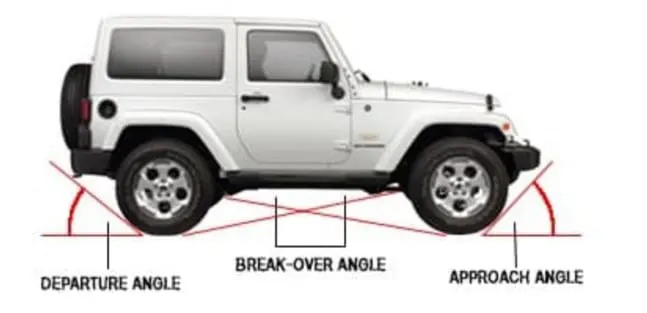
It is not possible to determine the trails that you can safely navigate without have a proper idea about the ground clearance of your vehicle.
Minimum ground clearance of your vehicle depends upon several factors, it is not dependant on any single factor.
The factor determining the minimum ground clearance of your off-road vehicle are as follows:
| Ground Clearance Determining Factors | Explanation |
|---|---|
| Type of off-roading | You cannot adjust the needed ground clearance of your vehicle without having an idea about the type of off-roading. Off-roading is not restricted to single terrain; it is a complex activity with many types ranging from mild to severe. You can decide the minimum ground clearance for your vehicle after inspecting the selected terrain. |
| Sand dunes and Rock crawling | Sand dunes and Rock crawling both are different types of off-roading. You cannot select the vehicle with ground clearance suited for rock crawling if you want to proceed with your journey through sand dunes. |
You can have a better idea about the selection of vehicles with required ground clearance for the selected route after having basic knowledge about the ground clearance issues delineated as follows:
Determining Ground Clearance- Approach Angle:
Approach angle can be defined as the maximum ratio of angle lie between the obstacles and the lowest component of your off-road vehicle front bumper.
In simple terms, you can understand this term by measuring the distance between the ground and the lowest part of the front bumper.
Damage due to Low approach Angle:
If you try to surpass any obstacle by proceeding with a vehicle having a low approach angle, you can end up your journey by damaging the rear end of your off-road vehicle.
Low approach angle can prove to be deadly dangerous for the undercarriage components of your off-road vehicle.
You cannot proceed to every terrain by using a low approach angle as it results in scrapping. If you are willing to surpass rough terrain, it should be best for you to select the off-road vehicle with a high approach angle.
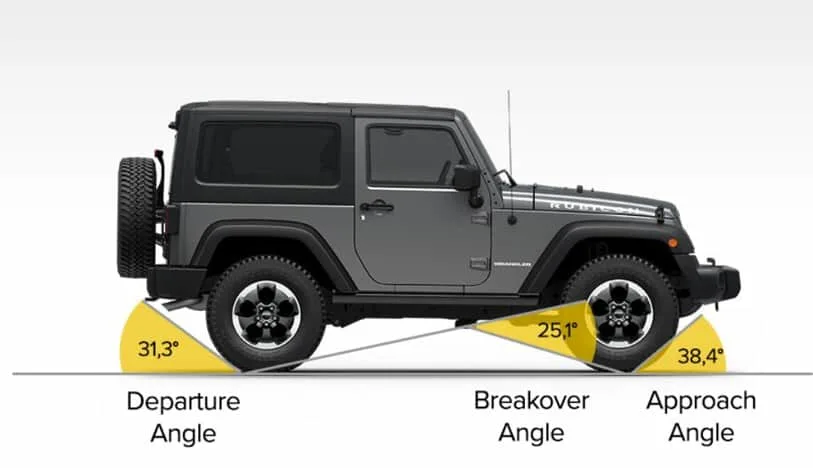
Approach Angle 40 degree– Jeep Wrangler:
You can proceed with your off-road journey through rougher terrains by selecting jeep wrangles. They hold a high degree of approach angle necessary to surpass obstacles quite easily compared to off-road vehicles with a low approach angle.
You don’t need to have a high degree of approach angle vehicle if you want to proceed through dirt roads, but you cannot proceed to rougher terrains. Every off-road vehicle holds a specific vehicle approach angle that represents that this off-road vehicle can surpass this obstacle without damaging the undercarriage or any other component.
Determining Ground Clearance- Departure Angle:
Departure angle can be defined as the distance measured between the lowest component of the rear end of the vehicle and the obstacle that had been passed.
You can risk the rear end of your off-road vehicle if you are proceeding through obstacles with the vehicle having a lower departure angle.
You can avoid this from happening by selecting the jeep wrangler for your off-road journey. Jeep wrangler holds a departure angle of 37 degrees that is quite higher than other off-road vehicles.
How to Improve the Departure Angle of the Off-Road Vehicle?
There are many ways to improve the departure angle of your off-road vehicle. We have selected the most trusted ways to accomplish this task.
You can improve the departure angle of your off-road vehicle by using bigger tires. Tires are the most important component to determine the performance of your off-road vehicle.
Bigger tires would be helpful to improve the departure angle of your off-road vehicle. Another way to improve the departure angle of your off-road vehicle is by replacing the bulky bumpers of your off-road vehicle. In doing so, you can improve the departure angle of your off-road vehicle.
Have a read on: What Size Dirt Bike Should I Get? Make Off-Road Amazing
Determining Ground Clearance– Break-Over Angle:
Break over angle can be defined as the angle measured between the lowest components of the undercarriage of your off-road vehicle and the tires of your off-road vehicle.
Break-over angle is critical in those situations when you have to surpass larger obstacles. When you drive through a big obstacle, your vehicle can get high centered on the object.
Break over the angle of your off-road vehicle represents the steepest crest that your off-road vehicle can traverse without high-centering. You can select the vehicle having a short wheelbase to get over the obstacles without any damage.
Other Factors:
| Factors Impacting Ground Clearance | Explanation |
|---|---|
| Weight of equipped components | Fully loaded vehicle can impact the ground clearance of your off-road vehicle as compared to those vehicles having no additional load. |
| Inflation of tires | Inflation of tires can impact the ground clearance of your off-road vehicle. A vehicle with fully inflated tires can have high ground clearance as compared to those having deflated tires. |
Required Ground Clearance in Different Terrains:
The value of suitable ground clearance of your off-road vehicle varies from terrain to terrain. You cannot go with the same ground clearance through dunes and snow areas.
It should be best for you to adjust the ground clearance of your vehicle according to the selected terrain.
| Selected Terrain | Required Ground Clearance |
|---|---|
| Well-maintained terrain | 6inches |
| Snow terrain | Harsh terrain (more than 10 inches) |
| Overlanding in rocks and mountains | 8 to 10 inches |
Ground Clearance While Driving Through Snow:
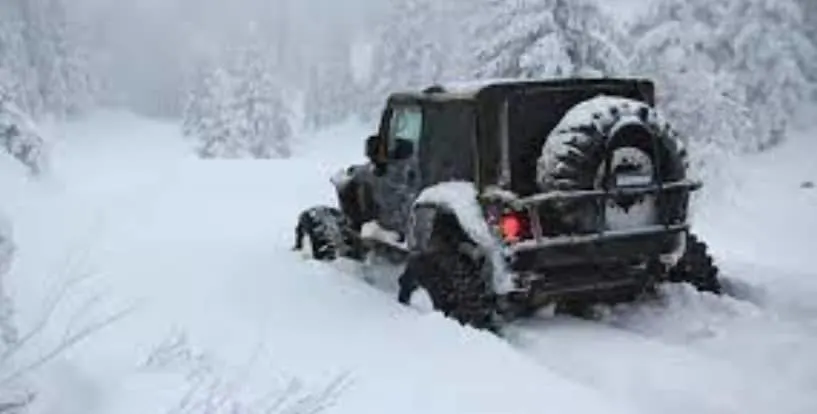
You cannot drive through snow in-vehicle having low ground clearance. SUV can be the best option while driving through snow areas as these types of off-road vehicles hold high ground clearance to tackle the obstacles imposed by snowy routes.
While driving through snow, you should take care of the speed of your vehicle and ground clearance. You have to clear the snow; otherwise, just moving your vehicle’s tires will not help you get out of trouble.
You should select the off-road vehicle with 8-10 inches of ground clearance if you want to successfully drive your vehicle through the snow.
These types of vehicles are greatly used in snowy areas to tackle challenges.
If you have to select the vehicle between sedan and SUV, you should select the latter one because SUVs possess high ground clearance compared to sedan vehicles.
The average ground clearance of sedan vehicles is between 4 to 6 inches; on the other hand, SUVs possess the ground clearance of 8 to 10 inches as required for the snow areas.
In extreme situations, you have to select the vehicle imparting higher ground clearance to tackle the situation. Some off-road vehicles possess height adjustable pneumatic suspension that augments the value of ground clearance.
More ground clearance always proves to be very helpful in extremely snowy conditions; otherwise, it becomes very difficult for you to surpass those areas.
Terrain | Ground Clearance | Appropriate Vehicle |
Snow terrain can be referred as the harsh terrain and is required high ground clearance. | Ground clearance of at least 8 inches to 10 inches is required. | Appropriate vehicle which can survive in these critical situations can be SUVs as they possess higher ground clearance of 8 inches to 10 inches. |
Ground Clearance for Overlanding:

If you decided to overland, there are certain factors you should keep in mind before proceeding to the terrain. You should be clear in mind about terrain selection because you have to adjust ground clearance following these factors.
It should be best for you to ensure the ground clearance of your vehicle 8 inches minimum and 10 inches maximum to tackle different situations.
During the off-road journey, your main concern is always the safety of your buddies, and you cannot compromise their safety. You can also maintain the standards of your vehicle by selecting the proper AT tires with 3ply sidewalls.
While driving your vehicle through rougher terrain, you should take care about the center of gravity of your vehicle and always ensure that your vehicle would not turn into a heavily loaded vehicle; otherwise, it can hurt your vehicle’s performance.
Arch cleaner and taller tires can be used to impart diff heights and if you want to increase the departure or approach, then go with a body lift. You can face larger obstacles while over-landing as it is all about exploring hidden places.
If you want to be in a safe zone during your journey, you should not ignore the importance of ground clearance of your off-road vehicle.
Importance of Ground Clearance for Your Off-Road Vehicle:
If you have decided to venture into unknown places and you have to drive through harsh terrains. In this situation, you cannot go wrong with the selection of vehicles and ground clearance.
If your vehicle lacks this particular department, you can put your vehicle in a lot of trouble. You have to pay for damages due to your negligence, and it will cost you heavily.
Your off-road vehicle can undergo serious body damages while driving through rocks and other large obstacles. How can you avoid this destruction? It depends upon the type of off-roading that you have selected to conquer.
If you plan to take your off-road vehicle to extreme off-road terrains, it should be best for your vehicle to have higher ground clearance.
Benefits of High Ground Clearance:
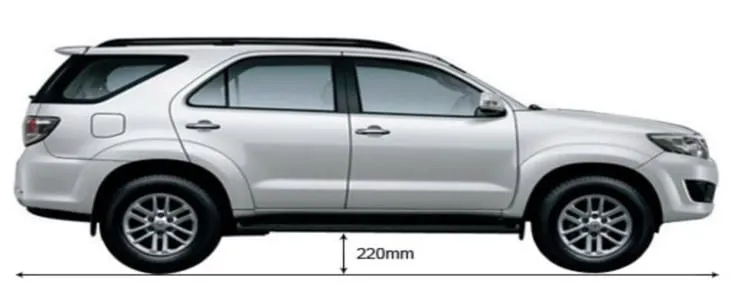
Higher ground clearance and ride height ensure that the vehicle has more capacity to endure bumps and absorb shocks.
If your off-road vehicle possesses high road clearance, then the wheels of your vehicle have more vertical room to travel. Off-road enthusiasts always look for the vehicle with high ground clearance because these vehicles are designed to endure tougher challenges imposed by off-roading.
These types of vehicles can easily drive through unpaved roads compared to other vehicles with lower ground clearance.
Also Read:
What Tire Pressure for Off-Roading Is Suitable-Tune the Tire
Does Off-Roading Void Warranty? How to Check Your Vehicle
Frequently Asked Questions (FAQs):
Does TIRE size affect ground clearance?
The tires of your off-road vehicles can be the decisive factor in determining the performance of your vehicle. Tires are one of the most crucial components of your vehicle, directly impacting different components of your vehicle.
Tires can directly impact the ground clearance of your off-road vehicle. Ground clearance of your off-road vehicle can be increased by using larger tires. This is one of the most effective methods to improve the ground clearance of your vehicle.
If you want to improve the ground clearance of your off-road vehicle, you can do so by upgrading the 165/55 to 165/65, which will get you more tire sidewall that will improve the ground clearance of your vehicle.
How can I increase the ground clearance of my truck?
You can increase the ground clearance of your truck in many ways. The most common way to increase ground clearance is to increase ground clearance by adding a suspension lift kit or body lift kit. Ground clearance is one of the main aspects to determine the fate of an off-road journey.
You are not allowed to take your vehicle in extreme situations without checking the ground clearance of your vehicle. Your truck can surpass larger obstacles easily when you improve the ground clearance of your vehicle by adding a suspension lift kit. If you don’t do this, it will cause your vehicle to bottom out while passing through the larger obstacles.
Why do cars have low ground clearance?
Low ground clearance of the vehicle indicates that the vehicle has a low center of gravity. If you are driving your vehicle through a well-maintained track, low ground clearance can prove better in some aspects.
That vehicle that posses low ground clearance observes fewer air passes while driving. Low ground clearance imparts better control in some cases, and it keeps your vehicle adhere with the ground.
But if you are planning about proceeding towards harsh terrain, it is advisable to proceed with the vehicle having high ground clearance. Racing cars require low ground clearance because drivers always want to gain more control.
Why do luxury cars have low ground clearance?
Luxury cars need to have low ground clearance. These types of vehicles are designed to drive at high speed and have a sharp response. In this critical situation, the vehicle’s stability is the most important factor to ensure the safety of the passenger.
The low ground clearance can be the most effective way to impart stability to your vehicle while going through different routes at high speed. It will be best if you know how low ground clearance imparts great stability to your vehicle. Low ground clearance creates a vacuum beneath the car, so it gave rise to suction force that keeps your vehicle on the ground.

This is Surya. I am an experienced off-roader. I have been off-roading for many years across several terrains. I am passionate about 4×4 driving and want to share my knowledge and experience with others.
My goal is to provide you with the most comprehensive and unbiased information about off-roading.
I curated this article through my personal experience and expertise, and I hope it helps you with what you are looking for.

 (+91)9123743026
(+91)9123743026
 24/1 Nibedita Sarani. M.B. Road, Kolkata- 700051, India
24/1 Nibedita Sarani. M.B. Road, Kolkata- 700051, India
What Is The Most Reliable Off-Road 4×4 ATV? – Off-Road Handbook
Tuesday 22nd of March 2022
[…] LRM style suspension upfront, and our bag provides 7.3 and 8.5 inches of travel and 9.4 inches of ground clearance. The front end rides quite smooth and seems to soak up pretty much anything. You can throw at […]
Can You Drive a Sedan Off-Road? All You Need to Know – Off-Road Handbook
Wednesday 9th of March 2022
[…] delineated options after analyzing the key specifications of these vehicles. You cannot ignore the importance of ground clearance while taking the final decision about selecting your […]
What is Off-Roading? Definition and the Significance – Offroadhandbook
Thursday 23rd of December 2021
[…] Ground clearance is important because it determines how well your car can travel over obstacles. Physics can help you calculate the necessary ground clearance for a particular terrain. You need to know how high the obstacle is and how wide it is and what type of surface it’s on (gravel, sand, mud, etc.). […]
How Much Do Off-Road Tires Cost? Regressive Analysis – Offroadhandbook
Saturday 11th of December 2021
[…] Check Out: What is a Good Ground Clearance for Off-Roading? Know in Detail […]